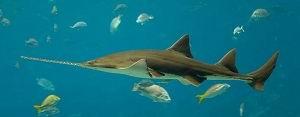
Bycatch is the most serious issue threatening the smalltooth sawfish today (Seitz & Poulakis 2006; NMFS 2009). The historical range of the species stretched along the coast from New York to Texas, but is now restricted to the coastal waters of Florida (Seitz & Poulakis 2006). Smalltooth sawfish populations have declined so drastically that an estimate by the National Marine Fisheries Service put the current number of animals at less than 5% of the individuals present during European colonization (NMFS 2009). Because of its elongated, saw-like rostrum, the smalltooth sawfish is at particular risk for accidental entanglement, and is often difficult to free from gear without causing injury or death (Seitz & Poulakis 2006; Martin 2005). Even if a fish is successfully released, the loss or damage of the teeth protruding from the rostrum, or the wounding of the rostrum itself, can result in decreased ability to feed (Seitz & Poulakis 2006).
The smalltooth sawfish is at risk of extinction throughout its range (NMFS 2009). This species, like other sawfishes, is slow to grow and to mature, and produces few offspring per generation (Seitz & Poulakis 2006). This means it has been exceptionally difficult for the population to recover after being negatively impacted by excessive bycatch in the 1800s and 1900s (Seitz & Poulakis 2006). The plight of the smalltooth sawfish mirrors that of the other six sawtooth species, each of which is currently threatened by bycatch-related issues and is in danger of extinction. Three species (Pristis clavata, pristis zijsron, and Anoxypristis cuspidata) are listed as Critically Endangered by the IUCN; the other three species have not yet been assessed.
In the US, possible mitigation measures are (1) reducing human interactions with the smalltooth sawfish population, and (2) reducing habitat destruction and fragmentation as well as restoring habitat in some areas. Specifics include a public awareness campaign and training fishermen in the safe handling and release of sawfish (NMFS 2009).
References
Martin, RA. 2005. Conservation of freshwater and euryhaline elasmobranchs: a review. Journal of the Marine Biological Association of the United Kingdom 85(5):1049-1073.
National Marine Fisheries Service (NMFS). 2009. Recovery plan for smalltooth sawfish (Pristis pectinata). Prepared by the Smalltooth Sawfish Recovery Team for the National Marine Fisheries Service, Silver Spring, Maryland. PDF available http://www.nmfs.noaa.gov/prp/pdfs/recovery/smalltoothsawfish.pdf. Accessed 31 October 2012.
Seitz, JC & GR Poulakis. 2006. Anthropogenic effects on the smalltooth sawfish (Pristis pectinata) in the United States. Marine Pollution Bulletin 52:1533-1540.
